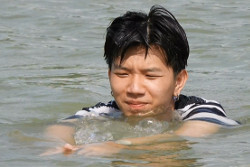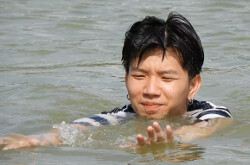Breaststroke
Lifeguards use breaststroke when approaching casualties to keep an eye on them and talk to them reassuringly.
The downside is that it it not as fast as front crawl. You may want to do the initial approach with front crawl and switch to breaststroke during the final approach.
Breaststroke is the most popular recreational swimming style due to its stability and that you keep your head out of the water at all times. In most swimming classes, beginners learn either breaststroke or front crawl first. It is also the easiest and most efficient stroke for swimming in clothes.
Sloppy Skills
Breaststroke often suffers from sloppy skills, because it works even you do it wrong.
Swimming in clothes forces you to do the breaststroke right.
Begin in
Key Points
You swim breaststroke while leaning forward. Your body is often at a steep angle to the forward movement. This slows you down more than any other style. Keep your position as level as you can.
Your arms only slightly break the surface of the water and your legs stay always underwater. Your head may be underwater for the second half of the stroke to trim your body into a more level position.
Your feet should not come out of the water.
Keep your body level at the surface.
Your shoulders need to be in line and your hips also need to be flat in the water.
It is all about the efficient timing of the leg kick and arm cycle.
Reach forward and kick backward
Start by stretching your arms out in front of you, just under the surface of the water. Both hands, thumbs together, reach forward, fully extending the arm at the elbow. The leg kick starts to push back to continue the forward movement.
Kick your legs apart and backward. Turn your feet out so that you can push back with the bottom of your foot, like when you kick a door shut. The leg kick is sometimes referred to as a "frog kick". Some people use the abdominal muscles and hips to add extra power to the kick, although most do not perfect this technique until the advanced level.
Next move your feet and legs together.
The arms will stay in the forward position until the kick is completed by the feet touching.
Glide as far as you can.
Glide like a Torpedo
Stay long and streamlined to carry your gliding speed faster and farther. As you start each stroke with a fingertips-to-toes body line stretch you are almost 50% longer than standing up and streamlined to slip that line through the smallest possible "hole" in the water. Take long stretches between each stroke with your arms.
While gliding in this position, lean on your chest enough to feel as if you're gliding "downhill." This helps raise your hips so they're ready to rock forward in the short-axis body rotation that generates the power what drives your stroke.
Your head should be as close as possible to your body's natural line, which means you'll be looking down, with your head low between your arms. The guy in the wetsuit on the photo has got it right.


Keep your hands together.

Then begin the sweep.
Sweep out to a Y position
After completing your extension and glide, continue to lean on your chest and elevate your hips while sweeping your hands out to a Y position. Virtually every bit of your pull is a sculling movement. as if your hand, wrist, and fore arm were a blade.
Anchor your hands in the water as if there is something solid to grab and pull your body toward your hands. Concentrate on keeping your head in line with your spine.
Your arms and legs should stay in the water all of the time, making no splash at all. The hands rotate laterally, cupped to catch the water, and press laterally with slight flexion of the arm at the elbow.
As your hands reach the Y position, lift your elbows toward the surface. Your elbows should stay at the eye line.
If you use your high elbows as a hinge for the inward sweep of your hands and forearms, you'll create the leverage you need to use your abdominal muscles to bring your hips forward.
The action is similar to a stomach crunch. This takes the pulling load off your weaker arm muscles and shifts it to your far more powerful torso muscles.
Sweep your hands in
Press both hands out and round to draw a full circle, making sure your hands stay in front of your shoulders. Your hands should finish by stretching forwards again.
Once you begin the in-sweep, scull your hands directly back toward the front. When you do it properly, your hands complete all their sweeps in front of your chin.
A really good tip is to make sure you can always see your hands. This will help to get the arm action right. Keep your hands as far in front as possible. Most swimmers pull back too far; when they think they're only sculling, they're actually stroking the right way.
The arms continue to flex at the elbow as the pressure on the water is now turned medially towards the chest. The legs flex at the knee and hips to prepare for the next kick.
Breathe in as you finish the circle, lifting your face out of the water. Your arms are finishing the in-scull by squeezing in from the side and lift your shoulders up and forward, a bit like a "shoulder shrug"; Your body lift carries your mouth clear of the water. Move your whole body as a single unit, including your head.
Your hips are also at their best point for using them as a platform to launch your upper body forward as you kick. Think of your body as a bow and arrow. Your body becomes a bow that stores energy in your hips. In the next moment it becomes an arrow as you dive forward and release the energy from the shoulder end. Keep a low, narrow profile as you get set to dive forward.
Once at the chest, the hands meet in the centre, elbows flexed close to the chest to reduce drag, and recover together over the water at the beginning, but then dive in to the reach and glide.
Put your face back into the water as you stretch your arms forward to begin the circle again. Your head has reached its highest point, and you're still looking down.
Forward Dive
This is where you maximise your stroke length. Your head has reached its highest point and the angle of re-entry is critical to creating the greatest possible wave length. Keep your head and shoulders hunched low as you finish your in-sweep, so your angle of re-entry is shallow, causing your momentum to channel forward.
Return your hands to their full extension before your face re-enters the water, and make sure the crown of your head follows your fingertips forward.
The potential energy created by lifting so much of your body mass above the water on the in-sweep is converted into kinetic energy going forward.
If your hands stall under your chin, you'll sink instead of driving forward.
Complete the dive by returning to the long, streamlined, downhill-sliding position you started in.
Squeeze your body from fingertips to toes into a long, sleek torpedo position.
If you slice just inches below the surface, you'll avoid more drag, since drag is far less just under the water than at the surface.
Practice your leg kick
You can do it in the water by holding on to a float or on the pool side with your legs stretched out.
Alternatively, you can try this sitting on the side of the pool with your legs dangling in the water.
Bend your knees and lift your feet up to your bottom.
Kick your legs apart and outward.
Move your legs and feet to meet each other.
Repeat.
Constantly improve your technique
Keep learning new things about breaststroke. As one aspect becomes more natural, shift your attention to something else.
To break through to a new level in your breaststroke, don't hammer it, polish it, like a jewel. Timing and coordination are so delicate that you can find yourself mired in frustrating periods, wondering if you'll ever "find the groove" again.
To find your groove, you must first find your hips, how to drive them forward on the in-scull and how to let them ride up a bit on the glide. It's the part of technique you should work on the most. Head position and breathing are two more aspects of technique that have enormous influence on how well you can tap into your hip-generated power.
Keep your stroke in shape with drills.
Nothing puts your stroke right as quickly as stroke drills.
In fact, just minutes before some of the best competitive swimmers go off the blocks at major championships,
they are in the warm-up pool, getting in a few last-minute tune-up lengths with stroke drills.
That is clearly a strategy which works.